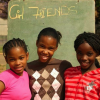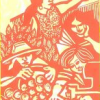Led by Elia Varela Serra and with the participation of Ruben Hilari of the project Jaqi Aru.
The main focus of the small breakout session was to explore the ways that internet has helped promote the uses of indigenous languages in countries where these languages have not had much presence online.
Ruben begins by saying that Aymara is not a new language, but perhaps it is a new language online. Aymara has about 5,000,000 speakers around the world and speakers of this language can be found concentrated in South America, mostly in Bolivia, Peru, Chile, and Argentina.
The goal of the Jaqi Aru project is to increase the presence of Aymara on the internet through 5 main activities, one of which is translations for the Lingua project site Global Voices in Aymara. Volunteers have been translating articles from Global Voices in Spanish for the past 7 months. In addition, the group has a collective blog site, uses web 2.0 tools like Facebook, Flickr, and YouTube, has been learning to subtitle videos on the platform DotSub, and has been starting to participate in the Wikipedia in Aymara community.
This is important for young people and when they look for information. They don't find a lot of information in Aymara and to make it available online. In addition, working with Wikipedia in Aymara may make it easier for people in the rural parts of the country access information in their own language through the use of offline capabilities.
Even though Aymara does not have a formal academy to make decisions on official translations for words that did not officially exist, the work of Jaqi Aru has helped put forth ‘proposals’ on what certain terms may be. In addition, there are groups across the region that are putting together dictionaries for terms, such as computer-related words, through a series of discussions and consensus-building.
One question from the audience was “What is the current state of online resources in Aymara?”
There are some sites online that discuss about Aymara culture, such as the site created at the BiblioRedes library in Northern Chile by Luis Carvajal, Wikipedia in Aymara, and other blogs, but there is still not a massive presence. Many who read/write in Aymara can also read/write in Spanish, so that may be one of the reasons why there is not many sites strictly in Aymara.
Another question asked whether there are plans to use social networking sites to teach Aymara? There are a couple of posts on the blog with basics in Aymara, and there have been some ideas on to upload videos to YouTube teaching people how to speak basic phrases in Aymara, but nothing concrete as of yet.
Juan Casanuevas brought up the issue of how indigenous languages relate to the educational system, and provides his experiences in Mexico, where there are 64 indigenous languages. He is working on a project to teach multimedia production in indigenous communities, but there are challenges in this type of activity. For example, the language of Nahuatl, which has about 1,000,000 speakers has up to 6 or 7 ways of writing it. These indigenous languages do not have the same tools that other languages have. Spanish can be spell checked according to different countries.
These projects of digital media has been directed to a broader social inclusion, and some media centers have emerged in Mexico to promote the writing of Mayan languages. The topics have included gender issues and other development topics.
This has led to the younger generations who are bilingual, and even trilingual, of which they are become prouder and prouder. Something that is reflected in the experience of the Aymara in El Alto.
He also spoke about intercultural universities in many of these communities, which encourages college-aged children to not migrate to larger cities and remain at home. He provides the opinion that the NGO sector have not been that involved in education in indigenous languages, and that there have been cases that of them being very aid-based and at times paternalistic.
Another question: What are the Aymara young people writing about?
Most of the members of the Jaqi Aru project live in the city of El Alto, which is a city comprised of migrants from the Altiplano. Some have moved to the city as young adults, others as children, and still others were born in the city. However, everyone has relatives in their communities of origin. Often they return home for festivities or to visit relatives, and they often write about their communities. There are some amazing pictures taken by some of the members that tourists or other Bolivians do not have access to, and that is reflected in the group blog.
Elia Varela Serra spoke about her project Maneno, which in addition to localizing blog platforms, encourages individuals to blog in indigenous languages. The platform is available in Akan, Hausa, Igbo, Zulu, Lingala, and Luganda. Even though there are people in these small language communities, the internet has been an important space to help people to not feel ashamed of speaking them in public, even if there is not a standardized form.
In addition, it adds international recognition to see it online and it has even helped advance the standardization in some countries. There was an example of the being part of advancing the debate of the use of these languages in national education.
In Mali, a French/English teacher decided to promote the use of the Bambara language and there was not any other website in this language. Eventually he was able to secure a job in the Ministry of Education as part of their digital literacy initiative.
Karlo from the Philippines spoke about the experience in his country. There are no similar grassroots activities like this, but most are academic in nature and do not appear online. For example, there are 12 other major languages in the country and the languages of the indigenous people are usually marginalized.
He asked Ruben about the organization of the process and how to attract interest.
In the case of Jaqi Aru, Ruben and another team member Dora Romero started with a blogging project in El Alto. From there, they joined and invited other linguistics students in El Alto to be part of the project. The key is to find devoted people and passionate about their language.
Simon from the USA shared his thoughts about these issues in the Native American communities. For example, the larger indigenous languages have been supported on a federal level to promote the Navajo language. In World War II, the language was used as a military code to send messages securely.
There is an organization called Cultural Survival, which provides funds to organize and teach indigenous languages.
However, on some reservations economic situations like unemployment is very high and cultural aspects are not a priority.
There is an interactive map produced by UNESCO that states there are about 2,500 languages at risk











4 comments
Glad to hear that.
I have written about the conflict with Mayan & Nahuatl on my blog:
http://tecpaocelotl.livejournal.com/4425.html
There is a very interesting project in Canada, BC called First Voices.
http://www.firstvoices.com/
Although this does not specifically use Web2.0 technology, it is a designed to capture the at risk languages of the First People of Canada. In BC alone, there are over 80 such languages and in the past, they were actively discouraged by the Govt. Now the number of people who can speak them is shrinking rapidly.
First Voices is a group of web-based tools and services designed to support Aboriginal people engaged in language archiving, language teaching & culture revitalization.